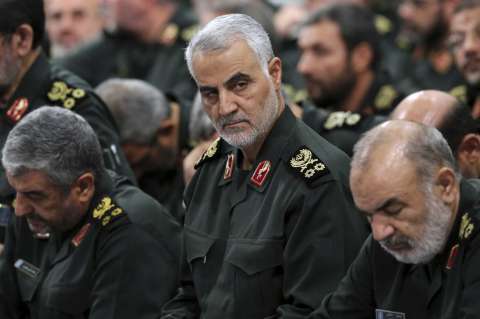Oil jumped toward $70 a barrel in London after a U.S. airstrike ordered by President Donald Trump killed a top Iranian general in Iraq, intensifying fears of conflict in the world’s most important crude-producing region.

Source: Houston Chronicle
Brent futures surged by more than 4% in busy trading on Friday to levels not seen since the attacks on Saudi Arabia’s oil facilities in September. The airstrike near Baghdad airport killed Qassem Soleimani, the Iranian general who led the Revolutionary Guards’ Quds force.
“This is a seismic event in the region,” said Jason Bordoff, a former Barack Obama administration official who now works for Columbia University. “This is how U.S.-Iran tit-for-tat spirals out of control. Iran’s response will be severe and deadly. And certainly may include escalating attacks on energy infrastructure.”
While no oil installations or production were affected, targeting one of Iran’s most powerful generals ratchets up tension between Washington and Tehran, heightening fears of an armed confrontation that could pull in other countries. Iran’s supreme leader, Ayatollah Ali Khamenei, vowed that “severe retaliation” awaits the killers of Soleimani.
Brent crude for March settlement climbed as much as $3.25, or 4.9%, to $69.50 a barrel on the ICE Futures Europe exchange, and traded at $68.90 as of 8:19 a.m. New York time. The global benchmark’s bullish options bias was the biggest since early November while the closely watched spread between the December 2020 and December 2021 contracts was at the strongest level since October 2018.
West Texas Intermediate for February delivery was 3.7% higher at $63.46 a barrel, after advancing as much as 4.8% to the highest level since May. Total aggregate volume for Brent and WTI was about 10 times the 30-day average.
Tensions have been building between Washington and Tehran after an Iran-backed Iraqi militia stormed the American embassy in Baghdad to protest deadly U.S. airstrikes earlier this week. Concerns in the region have persisted over the past year as Saudi Arabia’s energy facilities as well as foreign tankers in and around the Persian Gulf have been the target of several attacks. The area has five of OPEC’s biggest oil producers.

Source: Houston Chronicle
The U.S. and Iran are already facing off over Trump’s crippling economic campaign against Tehran and suspected Iranian reprisals. Defense Secretary Mark Esper said on Thursday that America was ready to deploy more force in Iraq after the attack on its embassy.
The attack on Soleimani rattled other markets. U.S. equity futures and the Stoxx Europe 600 Index slid, while most shares in Asia reversed or erased gains. Gold hit the highest in four months as investors sought safe haven assets.
The strike also escalates an already tense three-way situation between the U.S. and major oil producers Iran and Iraq. The two Middle East countries combined pumped more than 6.7 million barrels a day of oil last month, according to data compiled by Bloomberg, more than one-fifth of OPEC output.
Energy exports from both countries also rely on the Strait of Hormuz, the narrow and crucial oil and natural gas shipping choke-point that’s always in focus when Middle East tensions flair, particularly with Iran.
“This is more than just bloodying Iran’s nose,” Stephen Innes, chief market strategist at AxiTrader Ltd. said in a note. “This is an aggressive show of force and an outright provocation that could trigger another Middle East war.”
Oversupply Concerns
Still, the rally could just as easily subside. While prices initially soared after the attack on Saudi Arabia’s Abqaiq processing facility in September, crude then retreated in another sign that the market’s psychology has shifted from fearing supply shortages to a concern with a surplus, largely because of the U.S. shale revolution.
Furthermore, OPEC is sitting on vast amounts of spare oil-production capacity after reducing supplies for most of the past three years. Consuming countries from the U.S. to China control millions of barrels stored in strategic petroleum reserves that can be deployed to offset any shortage.
In the biggest sign of the oil market’s transformation, the U.S. reported its first months as a net exporter of petroleum, including crude and refined oil products, late last year for the first time in roughly 75 years. In October, America exported a net 389,000 barrels a day, compared with net imports of close to 9 million barrels a day a decade or so earlier.

